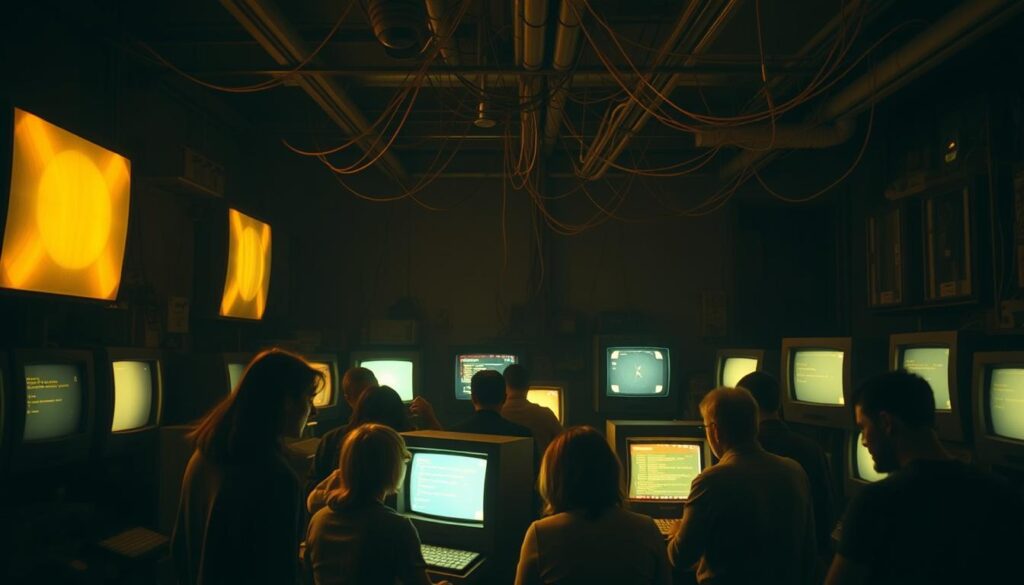Old Tech That Was Ahead of Its Time – Imagine a world where Old Tech That Was Ahead of Its Time led the way to today’s devices. From the first computers to early mobile tech, many Old Tech That Was Ahead of Its Time. These early achievements in vintage technology have greatly influenced how we live and work.

The stories of these retro gadgets and their creators are truly fascinating. They have played a big role in shaping today’s tech landscape. By looking into these early innovations, we can better understand their impact on modern technology.
Key Takeaways Old Tech That Was Ahead of Its Time
- Many Old Tech That Was Ahead of Its Time and paved the way for modern devices.
- Vintage technology has had a lasting impact on the way we live and work.
- Retro gadgets have played a significant role in shaping the technological landscape of today.
- Early innovations in mobile technology were surprising and influential.
- Understanding the history of vintage technology can provide valuable insights into the development of modern technology.
- The legacy of retro gadgets can still be seen in the devices we use today.
- Exploring Old Tech That Was Ahead of Its Time can help us appreciate the progress that has been made in the field of technology.
Understanding Old Tech That Was Ahead of Its Time
Technological advancements drive innovation, changing our lives. To see the value of Old Tech That Was Ahead of Its Time, we must know what makes it revolutionary. We look at its historical context and how it led to future tech.
The cycle of tech evolution never stops. Revolutionary innovation happens when a tech greatly improves what’s already out there. This leads to even more innovative devices, speeding up progress.
Defining the Impact of Old Tech That Was Ahead of Its Time
Old Tech That Was Ahead of Its Time, though outdated, has shaped our modern tech world. By studying tech history, we learn about innovation and its challenges. This helps us understand why some ideas were ahead of their time.
The Cycle of Technological Evolution
Technological evolution has ups and downs. New tech grows fast, then gets refined and solidified. This cycle repeats, with each step building on the last.
- Identification of a need or problem
- Development of a solution
- Refinement and improvement of the solution
- Widespread adoption and integration into existing systems
Understanding this cycle and old tech’s role in innovation is key. It shows the importance of tech advancements in our lives. They’ve changed how we live, work, and connect, and will keep shaping our future.
The Groundbreaking World of Early Computing
The history of old computers is a story of innovation and hard work. It started with the first electronic computers and the creation of programming languages. These early devices changed how we work, talk, and have fun.
Important moments include the making of ENIAC, the first electronic computer, and UNIVAC, the first commercial one. These old computers were huge, filled rooms, and used vacuum tubes. As tech got better, computers got smaller, quicker, and cheaper. This led to the era of personal computers we know today.
The effect of early computing on tech is huge. It set the stage for today’s computers, software, and the internet. The work of early computer scientists and engineers opened up new tech, jobs, and industries. We keep building on what they started, exploring new tech possibilities.
Key features of early computing devices include:
- Electronic computation
- Programming languages
- Input/output devices
- Storage systems
These features, though simple now, were huge steps forward back then. They helped create the modern computing we use today.
The Xerox Alto: The First Modern Personal Computer
The Xerox Alto is seen as the first modern personal computer. It brought new features that shaped future computers. It made computers easier to use with a graphical user interface.
The Xerox Alto had a graphical user interface. This let users interact with the computer using icons and menus. This was a big change from earlier computers that needed programming skills.
Key Innovations
- Graphical user interface
- Mouse navigation
- Ethernet networking capabilities
The Xerox Alto’s impact is still felt today. Its graphical user interface and mouse navigation are now common. This made computers more powerful, affordable, and changed how we work and play.
Ancient Mobile Technology: The Forgotten Pioneers
The history of mobile technology is truly fascinating. It spans many decades, from the first mobile phones to the latest mobile networks. Mobile technology has changed a lot over time. The forgotten pioneers who started it all are key to today’s smartphones.
Some important moments in mobile technology’s history include:
- The first mobile phone call made in 1973 by Martin Cooper, an engineer at Motorola
- The introduction of the first commercial mobile network in Japan in 1979
- The development of the first digital mobile phone in the 1990s
These breakthroughs led to the smartphones we use now. The forgotten pioneers like Martin Cooper and others worked hard. They made mobile devices and networks better. Their work changed how we talk and get information.

The growth of mobile technology shows our creativity and drive to improve. As we keep making mobile devices and networks better, we should honor the forgotten pioneers. They set the stage for the mobile technology we love today.
Digital Assistants Before Smartphones
Digital assistants have been around for decades, even before smartphones. These early devices introduced features like touch screens and early voice recognition systems. The Newton MessagePad, released in the 1990s, was a pioneer with its touch screen and handwriting recognition.
The Palm Pilot also played a key role. It allowed users to sync with computers and had many third-party apps. These devices laid the groundwork for today’s digital assistants, which are now a big part of our lives. Each new device added to the features and tech of the last, slowly building up to what we have today.
- Touch screens
- Handwriting recognition
- Early voice recognition systems
- Synchronization with computers
- Third-party apps
Today, digital assistants like Siri, Google Assistant, and Alexa do much more. They can set reminders and control smart home devices. The growth of digital assistants shows how innovation and early tech have shaped our modern devices.
Forgotten Social Networks of the Past
The early days of social networking saw many social networks and online communities emerge. These platforms let users connect, share, and discuss. They were the start of how we interact online today.
Prodigy, AOL, and CompuServe were some of the first. They offered email, chat rooms, and lots of online content. These services were key to connecting people back then.
Over time, social networks and online communities evolved. New tech and changing user habits led to today’s giants like Facebook, Twitter, and LinkedIn. They’ve changed how we connect and share online.

- Basic profiling and user accounts
- Chat rooms and discussion forums
- File sharing and exchange
- Early forms of online gaming
These early social networks and online communities set the stage for today’s social media. Their impact is still felt in how we use the internet.
Virtual Reality’s First Wave
The idea of virtual reality has been around for decades. Early VR systems came out in the 1980s and 1990s. These devices brought immersive experiences to the public, setting the stage for today’s VR.
The Virtual Boy, released by Nintendo in 1995, was the first VR gaming system. It was marketed as a groundbreaking device.
Early VR systems were big and pricey, making them hard to use. But they helped create better, cheaper VR tech later on. Key features of these systems included:
- Immersive graphics and sound
- Interactive controls and feedback
- Basic gesture recognition and tracking
In the 1990s, VR arcade systems started popping up. They offered a social, interactive way to experience virtual worlds. This marked the start of a new VR era.
Now, VR is used in gaming, entertainment, education, and healthcare. The early systems and arcades shaped the industry. Their impact is still felt in today’s VR tech.
Touch Technology Before the iPhone
The history of touch technology is quite interesting. It covers many years, from early devices to today’s systems. Companies and individuals have played a big role in its growth. The introduction of gesture controls was a major step. It let users interact with devices in new ways.
The IBM Simon Personal Communicator and the PalmPilot were early examples. They came out in 1994 and 1996, respectively. These devices showed the power of touch screens and gesture controls. Now, many smartphones and tablets use these features for a better user experience.
Here are some key milestones in the development of touch technology:
- 1965: The first touchscreen device is developed by E.A. Johnson
- 1982: The first multitouch device is developed by Bell Labs
- 1994: The IBM Simon Personal Communicator is released, featuring a touchscreen interface
- 2007: The iPhone is released, popularizing touch technology and gesture controls
Today, touch technology and gesture controls are part of our daily lives. They are used in healthcare, education, and entertainment. As technology keeps improving, we’ll see even more uses of touch technology and gesture controls in the future.
Revolutionary Storage Solutions
The way we store and access data has changed a lot over the years. From floppy disks to cloud storage, storage solutions have been key. They’ve helped shape how we work and live. The growth of data storage tech has let us store and get back lots of data. This has changed many industries and how we talk to each other.
Some big steps in storage solutions include:
- Hard disk drives (HDDs)
- Solid-state drives (SSDs)
- Flash drives
- Cloud storage
These new techs have made storing data better, faster, and cheaper. Now, data storage is more efficient, safe, and easy to get to. This has opened up new tech and uses.
In short, new storage solutions have driven tech forward. They’ve made it easy to store, get, and share lots of data storage. As tech keeps getting better, we’ll see even more cool storage solutions. These will keep changing how we live and work.
The Birth of Streaming and Digital Distribution
Streaming services have changed how we enjoy entertainment. Now, we can watch music, videos, and games from anywhere. This change has opened up new ways for businesses to make money.
With streaming, we can watch what we want, when we want. This has made it easier for people to find new things to watch. They can enjoy their favorite shows and movies anytime.
Early Music Streaming Services
Rhapsody was one of the first music streaming services, starting in 2001. Other big names like Spotify and Apple Music have also become very popular.
Digital Video Pioneers
YouTube and Netflix have changed how we watch videos. They offer a huge selection of movies, TV shows, and original content. This makes it easy for users to find what they want to watch.
Online Gaming Platforms
Platforms like Steam and Xbox Live have changed gaming. They let users play a wide range of games and connect with others worldwide. These platforms also make it easy to buy and download games directly to devices.
From Old Tech That Was Ahead of Its Time to machines that no longer exist, history is full of surprises.
Conclusion: Learning from Yesterday’s Tomorrow
As we wrap up our look at Old Tech That Was Ahead of Its Time, we now see the technological evolution and innovation legacy more clearly. We’ve seen how pioneers in computer vision and mobile and social tech paved our digital world. Their early innovations show us the power of embracing new ideas, even if they were ahead of their time.
The lessons from these innovators are truly valuable. They dared to dream big and take risks, showing us that progress often means stepping into the unknown. By learning from their successes and failures, we can face future challenges better. This way, we can build on the foundations laid by those who came before us.
Let’s be inspired by the innovators of the past and their dreams. By keeping their spirit of innovation alive, we can keep pushing what’s possible. Together, we can create a future that’s even more amazing than we can imagine.
FAQ
What is the importance of understanding Old Tech That Was Ahead of Its Time?
Looking back at Old Tech That Was Ahead of Its Time for its time gives us valuable insights. It shows us how technology has evolved over time. We learn to appreciate the work of early engineers and inventors who paved the way for today’s tech.
Why were some early innovations not readily adopted?
Several reasons led to the slow adoption of early tech. Lack of infrastructure, public doubt, and high costs were major hurdles. Understanding these challenges helps us see the importance of timing and adaptability in tech.
How did early computing devices pave the way for modern computers?
Early computing pioneers set the stage for today’s computers. From the first electronic computers to programming languages, their work showed the power of computing. This inspired further advancements in personal computers and digital devices, Old Tech That Was Ahead of Its Time.
What were the key features of the Xerox Alto, the first modern personal computer?
Old Tech That Was Ahead of Its Time – The Xerox Alto was a game-changer in computing. It introduced a graphical user interface, mouse navigation, and Ethernet networking. These features became standard in modern computers, thanks to the Alto’s innovative design.
How did early mobile technology and digital assistants foreshadow the rise of modern smartphones?
Early mobile tech and digital assistants like the Newton Message Pad and Palm Pilot were key. They introduced touch screens, handwriting recognition, and voice controls. These features showed the potential for portable, user-friendly tech, Old Tech That Was Ahead of Its Time.
What were some of the early social networks and online communities before the rise of popular platforms?
Before today’s social media, there were early online communities. Bulletin board systems and early social media platforms showed our need for connection. They paved the way for today’s social media landscape.
How did the first wave of virtual reality technology influence the development of modern VR?
The first VR devices, like the Virtual Boy, showed the promise of immersive experiences. Despite challenges, they laid the foundation for today’s VR industry, Old Tech That Was Ahead of Its Time.
What were some of the early innovations in touch technology before the iPhone?
Before the iPhone, there were early touch technology innovations. These included touchscreen devices and gesture control systems. They showed the potential for interactive user interfaces, leading to today’s touch-based experiences, Old Tech That Was Ahead of Its Time.
How did revolutionary data storage solutions transform the way we store and access information?
Data storage technology has changed how we store and access information. From floppy disks to cloud storage, these innovations have shaped our digital world.
How did the birth of streaming and digital distribution impact the entertainment industry?
Early streaming and digital distribution services changed entertainment. They introduced online content delivery, revolutionizing how we consume entertainment. These early efforts paved the way for today’s digital content access.
Source link
- https://interestingengineering.com/lists/7-ancient-inventions-that-were-way-ahead-of-their-time
- https://bigthink.com/the-past/examples-ancient-technology/
- https://www.texasflange.com/blog/15-forgotten-revolutionary-technologies-ahead-of-their-time/
- https://en.wikipedia.org/wiki/Bain%27s_facsimile
- https://www.thescroller.net/36065/20-forgotten-inventions-that-were-way-ahead-of-their-time/
